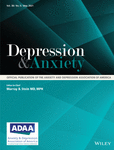Predictors of diagnostic delay: Assessment of psychiatric disorders in the clinic
Abstract
Background
Diagnostic delay contributes to morbidity in psychiatric disorders.
Methods
Patients in an ambulatory psychiatry clinic were given patient-reported outcome measures at an initial visit, and a subset (N = 493) were given a structured interview (MINI International Neuropsychiatric Interview, MINI), in addition to the clinical encounter (CLIN). Diagnostic agreement between MINI and CLIN was assessed at an initial and follow-up visit. Diagnostic delay was identified if diagnostic disagreement between MINI and CLIN occurred at the initial visit and changed to an agreement at a follow-up visit. Registry data was compiled by an honest broker.
Results
Significant agreement occurred between MINI and CLIN diagnoses for major depressive disorder (MDD), bipolar disorder (BD), generalized anxiety disorder, and panic disorder. Diagnostic agreement for MDD occurred at initial visit for 63% of patients, and at follow-up for 87% of those with initial diagnostic disagreement; for BD, 75% at initial visit and 28% at follow-up. No demographic, socioeconomic, symptom severity or functioning measures predicted diagnostic agreement for the MDD group at the first visit, however initial psychopathological symptom complexity predicted diagnostic agreement in the diagnostic delay group. Initial diagnostic agreement for BD was predicted by lower symptom burden and better social, physical, and occupational functioning. No factors predicted additional diagnostic agreement at the second visit in the diagnostic delay group.
Conclusion
Initial assessment by a structured interview aided physicians in identifying MDD by the second visit in patients with complex psychopathology. Patients with high complexity/severity of symptoms and more difficulty with functioning were less commonly identified with BD even with the assistance of a structured interview. Use of structured assessment tools may improve the detection of psychiatric illness by clinicians at the first visit.
CONFLICT OF INTERESTS
Erika F. H. Saunders: Grant funding from the Stanley Medical Research Institute; associate editor from the Journal of Clinical Psychiatry; advisory board, Myriad Neuroscience. Remaining authors declare that there are no conflict of interests.
Open Research
DATA AVAILABILITY STATEMENT
The data that support the findings of this study are available from the corresponding author upon reasonable request.




